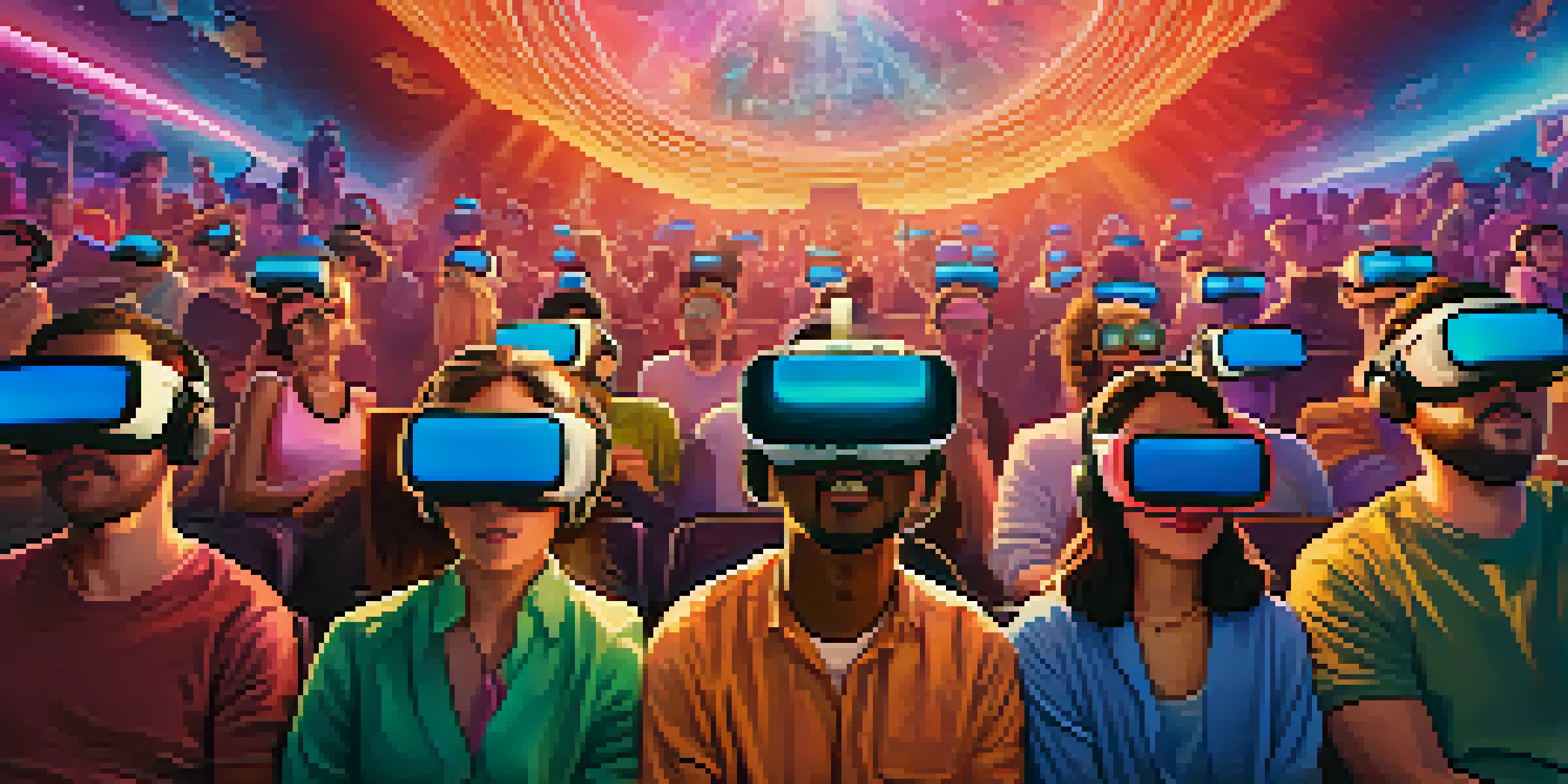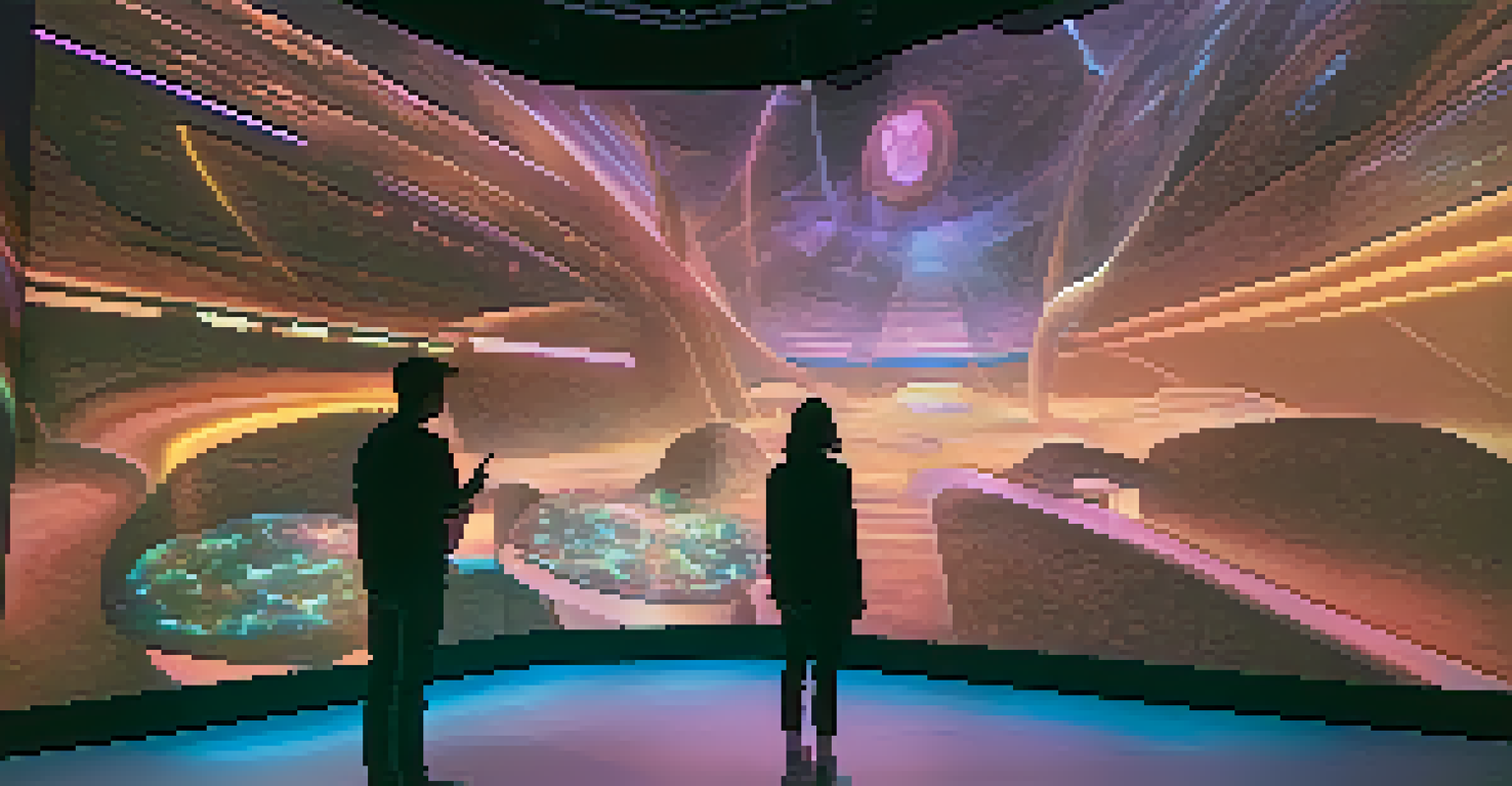The Future of Storytelling in Immersive Cinema Formats

Understanding Immersive Cinema: A New Frontier in Storytelling
Immersive cinema is transforming the way stories are told, allowing viewers to experience narratives like never before. Unlike traditional films that present a linear storyline, immersive formats encourage audience participation, making them integral to the narrative. This shift provides a more engaging experience, as viewers can navigate through different perspectives, creating a personal connection to the story.
The future of storytelling is not just about what we tell, but how we tell it.
One of the most fascinating aspects of immersive cinema is its ability to blend technology with storytelling. Virtual reality (VR) and augmented reality (AR) allow filmmakers to create environments where audiences feel as if they are part of the story. Imagine walking through a digital landscape or interacting with characters; this level of involvement can deepen emotional responses and enhance overall enjoyment.
As audiences increasingly seek unique experiences, the demand for immersive storytelling continues to grow. This trend is not limited to entertainment; it extends to education and training, where immersive formats can provide realistic simulations. By understanding this evolution, we can appreciate how these innovative techniques are shaping the future of storytelling.
The Role of Technology in Shaping Immersive Narratives
Technology plays a pivotal role in the evolution of storytelling within immersive cinema. With advancements in graphics, sound, and interactive elements, filmmakers can create richly detailed worlds that captivate audiences. For example, spatial audio can make sounds feel as though they're coming from different directions, enhancing the immersive experience.

Moreover, the rise of 360-degree video has revolutionized how stories are consumed. Viewers can control their perspective, looking around a scene as it unfolds, which adds a layer of personalization to the experience. This interactivity can lead to greater investment in the story, as audiences feel more like active participants rather than passive observers.
Immersive Cinema Transforms Storytelling
Immersive cinema invites viewer participation, creating a deeper emotional connection to narratives.
Additionally, emerging technologies such as haptic feedback and AI are set to further enhance immersive storytelling. Haptic technology allows users to 'feel' the story through vibrations or movements, while AI can tailor narratives to individual preferences, making each experience unique. This synergy between technology and storytelling is paving the way for a more dynamic future.
Audience Engagement: Shifting from Passive to Active Participation
In traditional cinema, audiences typically sit back and absorb the story presented on screen. However, immersive cinema invites viewers to become active participants in the narrative. This shift not only changes the way stories are told but also how they are experienced, leading to a more profound emotional connection.
Immersive storytelling is the art of creating experiences that engage the audience on a deeper level than traditional narratives.
For instance, in immersive theater productions, audience members often move through spaces and interact with performers, blurring the lines between audience and actor. These experiences can leave lasting impressions, as individuals feel a sense of agency in shaping the narrative. This transition can also lead to discussions about personal interpretations of the story, fostering community engagement.
As creators explore new ways to engage audiences, participatory storytelling is becoming increasingly popular. Social media platforms, for example, allow viewers to influence plot developments or character arcs in real-time. This interactive model not only captures audience interest but also creates a sense of ownership over the narrative.
Narrative Structures: Rethinking Linear Storytelling
Immersive cinema encourages filmmakers to rethink traditional narrative structures. Instead of a straightforward beginning, middle, and end, stories can be fragmented or nonlinear, allowing viewers to piece together the narrative as they explore. This approach mirrors the complexities of real-life experiences, where events don't always unfold in a predictable manner.
Consider films that utilize multiple viewpoints; each character's perspective adds depth and layers to the story. This technique not only enhances character development but also invites audiences to empathize with diverse experiences. By breaking away from linear storytelling, filmmakers can create richer, more nuanced narratives that resonate with a broader audience.
Technology Enhances Audience Experience
Advancements in VR, AR, and interactive elements allow filmmakers to craft rich, engaging worlds.
Furthermore, branching narratives—where choices lead to different outcomes—are gaining traction. These narratives not only increase replayability but also allow for personalized storytelling, catering to individual preferences. As audiences seek more engaging content, this innovative approach to storytelling will likely become a staple in immersive cinema.
Cultural Representation: Diverse Voices in Immersive Formats
The future of storytelling in immersive cinema also hinges on the representation of diverse cultures and voices. As audiences become more globalized, there is an increasing demand for stories that reflect a variety of experiences and perspectives. Immersive formats provide a unique platform for marginalized voices to share their narratives in authentic ways.
For example, immersive experiences can transport audiences to different cultural contexts, allowing for a deeper understanding of diverse traditions and histories. This not only enriches the storytelling landscape but also fosters empathy and connection among viewers. By embracing cultural diversity, filmmakers can create more relatable and impactful narratives.
Moreover, the rise of independent creators in the immersive space has led to a broader range of stories being told. These creators often draw from their own backgrounds and experiences, adding depth and authenticity to their work. As the industry continues to evolve, the inclusion of diverse voices will be crucial in shaping the future of storytelling.
Challenges in Immersive Storytelling: Balancing Innovation and Accessibility
While the potential of immersive cinema is vast, it also comes with its challenges. One significant hurdle is ensuring that these new formats remain accessible to a broad audience. High-tech experiences may require expensive equipment or specialized knowledge, which can limit participation for some viewers.
Additionally, the complexity of immersive narratives can sometimes overwhelm audiences. As filmmakers experiment with interactive elements and nonlinear storytelling, there's a risk that viewers might feel lost or disengaged. Striking the right balance between innovation and clarity is essential to ensure that audiences can fully enjoy the experience.
Diversity Shapes Future Narratives
The representation of diverse voices in immersive formats enriches storytelling and fosters empathy.
Furthermore, as the industry grows, standardizing immersive experiences could pose a challenge. With various platforms and technologies emerging, finding common ground may be difficult. Addressing these issues will be vital in making immersive storytelling a fully inclusive and enjoyable medium for everyone.
The Future of Immersive Cinema: What Lies Ahead
Looking ahead, the future of storytelling in immersive cinema is bright and full of potential. As technology continues to advance, we can expect even more innovative storytelling methods that expand the boundaries of creativity. From hyper-realistic virtual environments to AI-generated narratives, the possibilities are seemingly endless.
Moreover, as creators experiment with new formats and techniques, audiences will likely become more sophisticated in their expectations. This evolution could lead to a richer dialogue between filmmakers and viewers, as audiences seek out experiences that challenge and inspire them. The demand for compelling, immersive storytelling will only grow.

In conclusion, the future of immersive cinema holds exciting opportunities for both creators and audiences. By embracing innovation, diversity, and interactivity, storytellers can craft narratives that resonate deeply with viewers, transforming the way we experience stories for years to come.